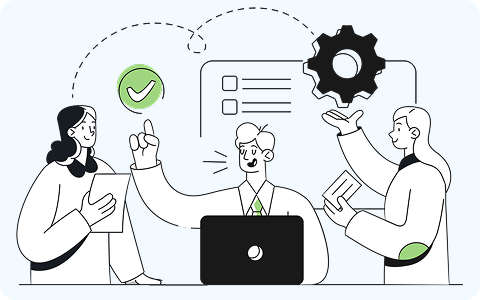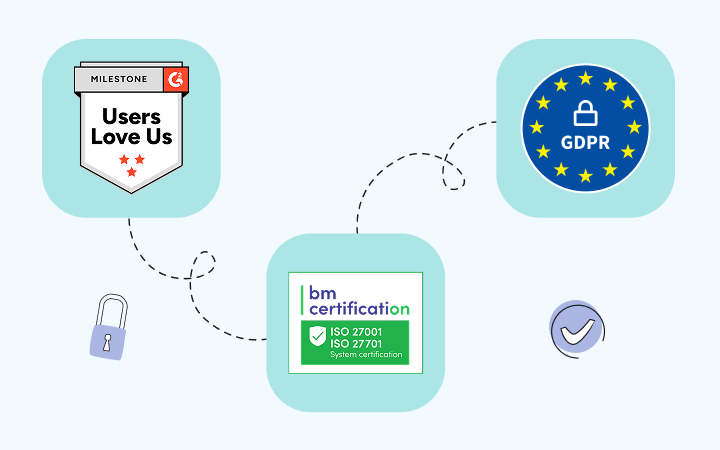


🍪 Allow functional cookies?
We use Zendesk messaging software for easy communication with our clients. Zendesk uses cookies to interact with website visitors and provide chat history.
See our Privacy Policy for more info. You can change your cookie preferences at any time in our Cookie Settings.





Choosing the right words can make all the difference—nobody knows that better than Skrivanek.
Skrivanek, a tech-powered language solutions agency, has been in business for around 30 years, providing translation and localization services in more than 80 languages. During those three decades, it has grown from a small office in Prague to a global leader in the language industry, with a team of 300 employees and branches in 10+ countries.
With that kind of scale, it’s crucial to Skrivanek that employees perform to the highest standards while also having the freedom to work at a time and place they feel most productive. But here’s the inevitable question: how can you allow your employees to work from anywhere without compromising their productivity?
The answer? DeskTime.
While most companies began thinking about productivity and time tracking only after the pandemic hit, Skrivanek was way ahead of the game. How long has it been since Skrivanek introduced DeskTime?
“It’s been with us for so long that it’s already hard to remember,” says Arturs, the company’s Business Development Manager, “We started using DeskTime long before the pandemic started. I suppose it’s been more than five years.”
He says the company outlined three main reasons for introducing time tracking:
Skrivanek wanted to give its employees more flexibility and allow them to work from home. A time tracking app allowed employees to work from anywhere they felt comfortable.
A time tracking app would be a safety net for managers, allowing them to monitor everyone’s work habits. Managers could ensure people started their shifts (especially crucial for customer service team members) at the agreed-upon time and check if someone was overworked or slacking off a little too much.
It was enormously important to Skrivanek that DeskTime worked as a self-tracking tool rather than a disciplinary tool. Employees could see their own productivity habits and understand what tasks took up the most time.
Arturs notes that there were additional important benefits for certain European offices, too. In many European countries like Poland or Slovenia, employers are required by law to keep track of their employees' working hours.
Before DeskTime, the employees in Skrivanek’s Polish offices had to manually sign timesheets, which took up a lot of time and focus. With DeskTime, Skrivanek was able to automate this process, saving time for both managers and employees.
Arturs is honest—not all employees were on board with DeskTime at first.
“People will always resist measures they perceive as threats to their privacy. Initially, employees thought [DeskTime] would be a punishment tool,” he says.
But Skrivanek took time and care to explain DeskTime to their team and set clear boundaries about how it would be used. Internal communication and meetings were focused on clarifying the benefits to employees and acknowledging potential issues.
While at first, employees were worried DeskTime would restrict their freedom at work, Skrivanek emphasized that the exact opposite would be true. DeskTime allowed employees to work freely from home without feeling micromanaged about how they spend their time or bothering with outdated manual time tracking methods.
Arturs also highlights that Skrivanek adopted a flexible approach to time tracking. DeskTime isn’t used to discipline or punish employees but rather to help them reflect and learn about how they spend their time at work. What matters most is that everyone is on the same page—both the employer and the employee.
“We have employees who regularly work less than their assigned hours,” says Arturs, “But they do the work at such a high standard that management doesn’t really mind.”
At the same time, when an employee complains about being overworked, DeskTime gives Skrivanek a chance to make informed decisions based on data instead of a feeling or a hunch.
“We can review the data to see what tasks take up the most time or catch potential time leaks. Then, we can sit down with the employee, help them prioritize their tasks, and minimize time waste,” says Arturs.
Arturs tells us that in the post-pandemic job market, employees have a much easier time getting used to the concept of time tracking.
“We haven’t had complaints from new team members. But everything depends on how you communicate—you have to be transparent and upfront during the interview stage that this time tracking app is a part of the company culture.”
Skrivanek’s experience shows that honesty and communication are the keys to a successful implementation of employee productivity monitoring in your team. As an employer, it’s crucial to be upfront with your employees about how you’re planning to use DeskTime and allow them a period of time to get used to the new software.
In addition, Skrivanek didn’t look at DeskTime as a micromanagement tool that restrains teams. Instead, it was seen as a tool that allows employees more freedom to work from anywhere without unnecessary interruptions.
Forget manual entries and distractions. With DeskTime, time tracking runs on autopilot—zero effort needed.